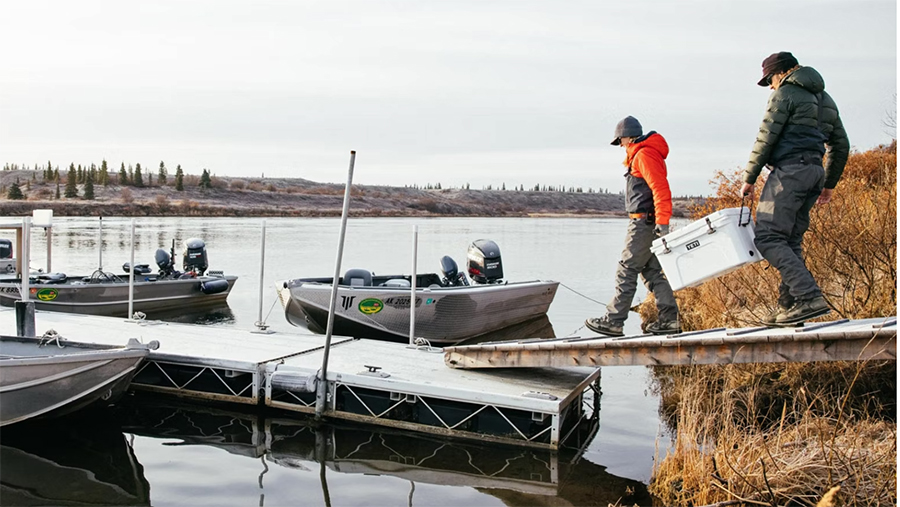Yeti’s moves to shift production out of China are ahead of plan with 90 percent of its U.S. drinkware capacity expected to be ex-China by the end of the year. However, delays caused by the sourcing shifts as well as the tariffs themselves caused the Yeti to ax its guidance for the year.
Under the updated guidance:
- Adjusted sales are expected to increase between 1 percent and 4 percent (versus the previous outlook of between 5 percent and 7 percent). The reduction in includes an approximately 300 basis point impact, primarily related to inventory supply disruptions in connection with the acceleration of its supply chain diversification efforts.
- Adjusted operating income as a percentage of adjusted sales of approximately 12.0 percent (versus previous outlook of 16.9 percent), reflecting a 450-basis point impact from higher tariff costs and includes its ongoing mitigation efforts.
- Adjusted EPS between $1.96 and $2.02 (versus previous outlook of between $2.90 and $2.95), reflecting the impact of higher tariff costs, as well as the effects of lower topline related to inventory supply disruptions.
On an analyst call, Mike McMullen, CFO, said that beyond supply chain constraints incurred within drinkware as Yeti transfers to new lines, Yeti halted shipments and shutdown production in China for over three weeks at the beginning of Q2. Several go-to-market changes related to the sourcing shift are leading to the delay in product launches until 2026 due to the expected limited supply. Several new products are also being launched outside the U.S. for the first time.
Finally, McMullen said the transition is having an overall impact on Yeti’s new product qualification and launch processes across all categories, as resources have shifted to diversifying drinkware production out of China.
In addition to the impact on growth from this supply chain disruption, the guidance change reflects the greater risk that a weaker overall consumer demand environment could materialize for the rest of the year.
“We are monitoring consumer behavior and wholesale inventory purchase patterns closely,” said McMullen. “While we see signs of strength in certain areas of our business, which we expect to continue, we also see an increased risk of an overall weaker market going forward
Tariff Mitigation Strategy
Collectively, the gross amount of the current tariffs that are included in the outlook is approximately $100 million.
Mitigation steps will a foremost focus on accelerating the diversification of its supply chain out of China, Matt Reintjes, president and CEO, said on the call. Secondly, Yeti is looking to lower costs in partnership with suppliers. He said, “Our suppliers are incredibly supportive. They drive participation in how we continue to get product to market, but also how we manage through this rising cost time.”
Yeti is also “tightly managing” its operating expenses and cash while also exploring select price increases. Reintjes said, “As it relates to pricing, we’ve always been very targeted and thoughtful about our pricing. We like pricing that’ll stick in the market. We want to make sure that we’re not swinging prices around, reacting to a moment in time, and the thing that we balance against everything is we will be in a very different situation in 2026 from a source supply in a country-of-origin perspective. So, we take all those things into consideration of the moment in time versus the long-term setup for the business.”
First-Quarter Results
The update comes as Yeti reported first-quarter results that topped analyst estimates.
In the quarter, sales increased 3 percent to $351.1 million, topping analysts’ consensus estimate of $347.5 million. The gains reflect FX headwind of approximately 100 basis points.
By channel, direct-to-consumer (DTC) sales increased 4 percent to $196.2 million while wholesale inched up 1 percent to $154.9 million.
Drinkware sales decreased 4 percent to $205.6 million as growth in international regions was more than offset by a decline in the U.S. region that was expected to be “challenging,” according to McMullen. Drinkware performance was also impacted by a challenging year compared to a 13 percent growth in the prior year quarter, as well as the slower cadence of new product launches due to supply chain diversification efforts. Stackable formats and straw bottles were among the newer products selling well in the U.S.
Coolers & Equipment sales increased 17 percent to $140.2 million on growth in the U.S. and international regions. Coolers & Equipment marked its fifth consecutive quarter of double-digit growth. In hard coolers, strong demand was seen for the Roadie 15 while portable formats such as backpack and flip coolers performed well in soft coolers. Bags were another highlight in Q1, with strong demand for both new and existing products. The Crossroads packs, Camino Totes and SideKick dry gear cases all posted strong growth while the new Ranchero backpack, introduced in two sizes, saw a strong launch.
Sales in the U.S. decreased 2 percent to $271.3 million. International sales increased 22 percent to $79.9 million, including an FX headwind of approximately 500 basis points.
Net income increased 5 percent to $16.6 million, or 20 cents a share. Adjusted net income decreased 12 percent to $25.8 million, or 31 cents a share, topping analysts’ consensus estimate by 4 cents.
Adjusted gross margin slipped 20 basis points to 57.3 percent primarily due to a lower mix of its Drinkware category and the unfavorable impact of foreign currency exchange rates, partially offset by lower product costs. Adjusted SG&A expenses increased 140 basis points to 47.3 percent, primarily due to higher general and administrative expenses and higher employee costs, including investments in headcount to support future growth. The FX headwind on earnings was approximately 2 cents.
Three Areas of Focus
Reintjes said Yeti is focusing on three key focus areas to manage through the tariff disruption: accelerating the pace of product innovation, “materially” transforming the supply chain by minimizing exposure to China, and delivering operating discipline to maintain a strong balance sheet
Yeti is on pace to introduce over 30 new product introductions in 2025 versus 24 last year as well as a “meaningful number of additional next-generation releases.” However, Reintjes said the supply chain disruption and go-to-market changes resulting from its sourcing diversification efforts will delay the benefits in the drinkware category.
“So, while the impact of innovation on our 2025 growth has changed due to shifting priorities, nothing has changed about our overall pipeline and our enthusiasm about what we have coming this year and beyond,” said Reintjes. “For instance, in drinkware on the back of the successful launch of food bowls, we have planned releases later this year across a range of hydration and food-related products, including an exciting lineup of insulated sports jugs. In Coolers & Equipment, we have additional releases planned for backpacks, thermal lunch bags and boxes, our first beach chair, and an extension in our go box protective case family.”
Reintjes noted that by the end of the year, the supply chain transformation is now expected to result in less than 5 percent of the company’s total cost of goods being related to products from China for the U.S. market. Reintjes said, “This is a remarkable transition due to the multi-year effort by our team and partners materially and strategically diversifying our global supply chain and putting us in a much-improved situation starting in 2026.”
Finally, Reintjes said Yeti will look to further strengthen its balance sheet amid the market’s uncertainty by working to offset costs in the supply chain in partnership with suppliers, executing on a number of operating expense reduction opportunities, lowering inventory levels, and reducing its planned capital expenditures for the year to focus resources on targeted supply chain and innovation programs. Reintjes said, “While managing through this period is our primary focus in 2025, we also believe that our supply chain diversification efforts will put us in a much stronger position starting in 2026.”
Image courtesy Yeti
















